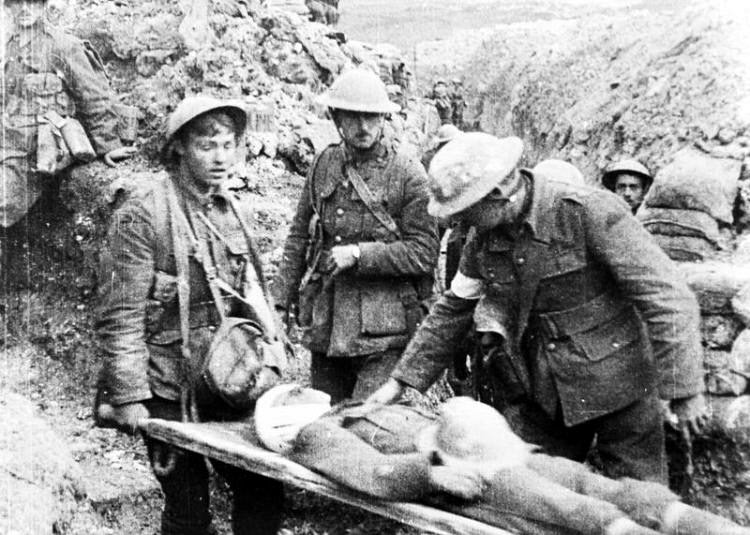
Arthur Gillson was born in Birstall in 1896, the son of Thomas and Ellen Gillson. In 1891, Arthur’s parents, Thomas and Ellen were living on Gelderd Road, Gomersal with their three children the eldest of whom was Emily, born in 1883, suggesting the couple may have married in the early 1880s. Thomas Gillson was working as a wheelwright.
In 1901 Ellen Gillson was living on Oaks Road, Hanging Heaton with her children Emily (born 1883), Bertha (born 1887), Martha (born 1891), Albert (born 1889) and Arthur (born 1897). However, Thomas Gillson, now aged 40, was still working as a wheelwright, but was boarding in Rochdale at the home of Gomersal born Anne Firth, aged 38.
In 1911 Arthur, aged 14, was living at Clay’s Building, Leeds Road, Chidswell with his widowed mother, Ellen, and his elder brother Albert who was a horseman on a farm. Arthur Gillson was working as a printer’s boy. It is not known when Thomas Gillson died and there is no trace of a death post 1901.
Arthur’s Medal Card indicates that he was awarded the British and Victory Medals, but not the 1915 Star, indicating that he did not serve abroad until after 31 December 1915. His medal card records that he “died of wounds” and his Service record has not survived. Arthur’s mother Ellen Gillson died in 1929 aged 74.
The 1/4th Battalion of KOYLI was formed in August 1914 at Wakefield and became a part of the 3rd West Riding Brigade, West Riding Division. They moved on mobilisation to Doncaster and in November 1914 to Gainsborough then to York in February 1915. On the 12th April 1915 they landed at Boulogne and on the 15th May 1915 the formation became 148th Brigade, 49th (West Riding) Division.
The CWGC web site records Private Arthur Gillson, 4852, 1st/4th Battalion, KOYLI, 148 Brigade, 49th (West Riding) Division was killed in action on the 12th of July 1916, aged 19, the son of Thomas and Ellen Gillson of Ossett, Yorkshire. It seems likely that he died in hospital at Puchevillers after being wounded in the Battle of the Somme.
The Regimental Diary records the following movements and it seems likely that Private Arthur Gillson was wounded on the 7th July 1916:
“1/4th (T.F.) 148th Brigade, 49th (West Riding) Division. In reserve at Aveluy Wood (1/7) – moving up to Thiepval Wood during evening and from there taking up positions for attack at midnight. Assault cancelled and back to Aveluy Wood. To Thiepval Wood (2/7), front line (4/7). Enemy attack drive off. Bombing attacks (5/7). Came under attack (7/7) – many casualties from new German “Egg” bombs. To Martinsart Wood (8/7), Hedauville (11/7)”
There is an account 1 of heavy fighting by the 1st/4th KOYLI on July 7th 1916:
“The Germans delivered a textbook artillery bombardment as a prelude to an attack in the first hour of the next day, July 7th. At 2 am, their guns were turned on the 1/4th KOYLI in the A lines and 50 minutes later shells began landing in the communication and support lines as they attempted to choke off the possibility of KOYLI reinforcements reaching the front line 2.50am. Enemy bombers advanced down the trenches towards A18 and A16 and across the open to A17. Furious fighting took place till 6.30am with lots of casualties from bombers and snipers who shot our men as they fired and threw bombs out of the trenches.”
“The 1/5th KOYLI sent 2 companies to reinforce the 1/4th, the remainder of the battalion being held in readiness in Ross St Trench. The evacuation of the ‘A’ line was completed by 7.30am.” The OH cites the use of the new ‘egg’ grenade by the Germans as an important feature in the enemy’s success in the attack. The casualties in the 1/4th were 20 killed and 180 wounded. The War Diary recorded 37 killed on the day.”
The ‘A’ Lines were sited in the original German front line and ran roughly from Ulster Tower down towards the Ancre, crossing the track that now leads from Ulster Tower to St Pierre Divion, so the 1/4th were at Thiepval rather than La Boiselle on 7th July 1916.

Above: Still from the 1916 film, “The Battle of the Somme” – Imperial War Museum.
Private Arthur Gillson is buried at Puchevillers British Cemetery 2, Somme, France at grave reference I. E. 44. Puchevillers is a village on the D11 about 19 kilometres north-east of Amiens. The British Cemetery is a little west of the village. The first Commonwealth War Graves Commission signpost is situated by the church in the village.
In June 1916, just before the opening of the Battles of the Somme, the 3rd and 44th Casualty Clearing Stations came to Puchevillers. Plots I to V, and almost the whole of Plot VI were made by those hospitals before the end of March 1917. For the next two months the 2nd/1st South Midland Casualty Clearing Station used the cemetery.
Plot VII contains for the most part the graves of men who died in the German advance in 1918, many of whom were buried by the 49th Clearing Station in March 1918, or by the 48th Labour Group in August.
Puchevillers British Cemetery contains 1,763 First World War burials.
References:
1. “Saturday Soldiers – the Territorial Battalions of the King’s Own Yorkshire Light Infantry, 1908-1919”, by Malcolm K. Johnson, published by Doncaster Museum Service (2004), ISBN 0903524309, 9780903524308